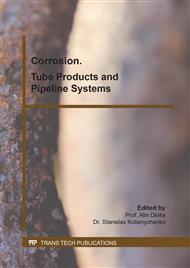p.1005
p.1011
p.1020
p.1028
p.1035
p.1040
p.1050
p.1061
p.1067
Corrosion Behavior Research of Aluminized N80 Tubing in Water Injection Well
Abstract:
In this paper, in view of the problem of tubing corrosion in the water injection well, it is proposed to use the aluminizing N80 tubing to improve the corrosion problem. An aluminized layer with a thickness of about 150 μm was prepared on the surface of commonly used N80 tubing. The electrochemical polarization test at room temperature and the high temperature autoclave test for simulated water injection well environment were carried out on both of the aluminized and non-aluminized N80 tubing. It is intended to provide a feasibility test basis for the application of aluminized tubing in water injection wells by comparing the corrosion resistance performance of the aluminized and non-aluminized N80 tubing. The results showed that the aluminized layer on the surface of N80 tubing had good adhesion due to the mutual diffusion layer, and the thickness of the aluminized layer can reach 150μm. Compared with the non-aluminized N80 tubing, the self-corrosion current density of the aluminized N80 tubing polarization curve decreased obviously in the water injection well environment, and the corrosion rate in the high temperature autoclave test was also reduced to one quarter of that of the non-aluminized N80 tubing.
Info:
Periodical:
Pages:
1035-1039
Citation:
Online since:
January 2019
Authors:
Price:
Сopyright:
© 2019 Trans Tech Publications Ltd. All Rights Reserved
Share:
Citation:



